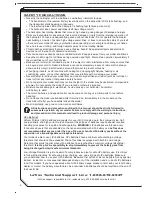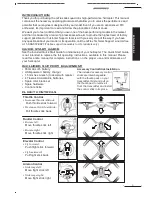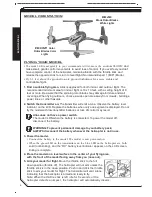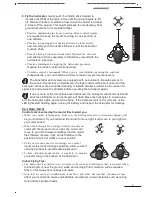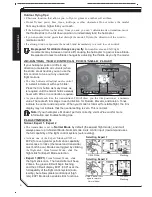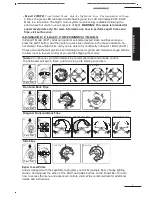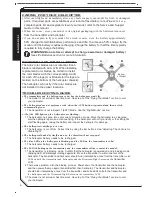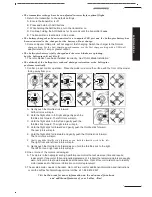
E
N
G
L
I
S
H
SAFETY PRECAUTIONS
•
Never fly the helicopter with low batteries. Low battery indicators include:
•
The transmitter or the receiver battery level indicator on the transmitter LCD starts flashing, and
the transmitter starts beeping continuously.
•
The rear-facing blue LED on the helicopter is flashing fast (4 times per second).
•
The helicopter loses power and lands itself (low voltage cutoff).
•
The helicopter has rotating blades that move at high speed, posing danger of damage and injury.
Pilots are responsible for any actions that result in damage or injury from the improper operation of
the helicopter. Choose an adequate flying space without obstacles. Do not operate the helicopter
near buildings, crowds of people, high-voltage power lines, or trees to ensure the safety of yourself,
others, and your model. Wear eye protection when operating your helicopter and keep your hands,
face, hair, loose clothing, and foreign objects away from the rotating blades.
•
This model has small parts that may pose a choking hazard. Keep all small parts and electrical
devices out of the reach of children and animals.
•
Pets can become excited by radio-controlled models. Keep pets away from your model at all times.
•
Keep the model in sight at all times during operation and flight. Discontinue operation immediately if
the model flies out of your field of view.
•
Because your model is controlled by radio, it is subject to radio interference from many sources that
are beyond your control. Radio interference can cause momentary losses of radio control; always
allow a safety margin in all directions around the model to prevent collisions.
•
When flying indoors, avoid locations with ceiling fans, hanging light fixtures, heating or air
conditioning vents, or any other obstacles that may interfere with or damage your model.
•
Never attempt to retrieve your model from any location higher than your reach (such as rooftops or
trees) or from any location that poses a safety hazard.
•
Do not operate your model anytime your line of sight to the model may be obstructed or impaired in
any way. Do not operate the model if you are tired or otherwise impaired.
•
Moisture causes damage to electronics. Avoid exposing your helicopter, transmitter,
and battery to water.
•
The motor, batteries, and speed control can become hot during use. Allow parts to cool before
handling.
•
Do not leave the model unattended while it is turned on. Immediately turn the model and the
transmitter off after you have safely landed the model.
•
Most importantly, use good common sense at all times.
All instructions and precautions outlined in this manual should be strictly followed to
ensure safe operation of your model. Failure to comply with the warnings, instructions,
and precautions in this manual could lead to product damage and personal injury.
LiPo Batteries
Lithium Polymer (LiPo) batteries are popular for use in R/C models due to their compact size, high
energy density, and high current output. However, these types of batteries require special care and
handling procedures for long life and safe operation.
WARNING
: LiPo batteries are intended only
for advanced users that are educated on the risks associated with LiPo battery use.
LaTrax does
not recommend that anyone under the age of 14 use or handle LiPo battery packs without the
supervision of a knowledgeable and responsible adult.
Your model is able to use LiPo batteries. LiPo batteries have a minimum safe discharge voltage
threshold that should not be exceeded. The LaTrax Alias is equipped with built-in Low-Voltage
Detection that alerts the pilot when LiPo batteries have reached their minimum voltage (discharge)
threshold.
It is the pilot
’s responsibility to stop immediately to prevent the battery pack from
being discharged below its safe minimum threshold.
Low-Voltage Detection is just one part of a comprehensive plan for safe LiPo battery use. It is critical
to follow all instructions for safe and proper charging, use, and storage of LiPo batteries. Make sure
you understand how to use your LiPo batteries. Be aware that LaTrax shall not be liable for any special,
indirect, incidental, or consequential damages arising out of the installation and/or use of LiPo batteries
in LaTrax models. If you have questions about LiPo battery usage, please consult with your local hobby
dealer or contact the battery manufacturer. As a reminder, all batteries should be recycled at the end of
their useful life.
LaTrax Technical Support Line: 1-888-872-9927
(Toll-free support is available to U.S. residents only, 972-265-8000 outside the U.S.)
2


